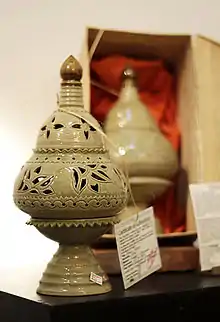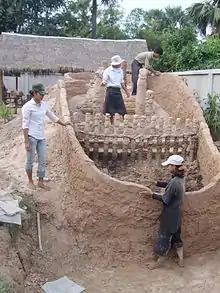Khmer Ceramics & Fine Arts Centre
Khmer Ceramics & Fine Arts Centre, formerly known as National Centre for Khmer Ceramics Revival (NCKCR), is an organization aiming to rediscover and reintroduce Khmer ancestral pottery techniques and support the development of contemporary Khmer ceramics art. In the process, the centre creates economic opportunities, helping to decrease poverty in Cambodia.[1] It is located in Siem Reap, Cambodia.

History
2006
- Khmer Ceramics & Fine Art Centre first begin with the name of : NCKCR (National Centre for Khmer Ceramics Revival).[2]
2007
- Reconstitution of a Cambodian traditional wood kiln 40 000 Litres. This kiln has mobilized 15 people for two months + 5000h work. The original kiln has been discovered at Phnom Kulen.
- 1st International Khmer Ceramics festival & Conference. The conference is held at the CKS center for Khmer study.[3]
2009
- November 2009 the NCKCR (National Centre for Khmer Ceramics) is relocated on the Temple Road.
- December 2009 the NCKCR is renaming ‘’Khmer Ceramics’’.
2011
- Khmer Ceramics is renaming ‘’Khmer Ceramics & Fine Arts Centre’’.
2013
- The 1st retail shop is open in the heart of Siem Reap ‘’Alley west street’’.
2014
- The center delocalized the Production Site & Kiln Site to Tramniak to expand the activity center located on the Temples Road.
- The center offers a new activity that involves painting on pottery bisque.
Research & Ancient kiln
Ancient Cambodian glaze
Research on Khmer Antique glazing and techniques - Antique Khmer ceramics are renowned, but the technology was lost during the recent terrible upheavals in Cambodia (Khmer Rouge). The center has sought to rediscover this technology, researching antique Khmer glazing, bisque, kilns, potters language etc.[4]
Ancient Cambodian Kiln reconstitution
In September 2007 the centre start the construction of an antique Khmer kiln (dragon kiln). The first firing as being done in December 2007 the first time in 500 years such kiln as being fired in Cambodia - a 10 day and night event. This kiln is the reconstitution of one of the largest wood kiln of the Khmer Empire 40,000 Litres (discovered at Phnom Kulen). It also allows to fire reconstituted antique Khmer glaze under the same conditions that it was made in Angkor. Such a kiln is a major tool in the research of antique Khmer techniques.[1]
Mr.Chhay Rachna (Conservation of Monuments in the Angkor Park and Preventive Archaeology, Cambodian government, APSARA Authority) held to assist the reconstitution. Mr.Chhay Rachna also participate with the ceramic production development to publish a poster ’’a guide to understanding Khmer stoneware characteristics from the late 9th to early 13th [5]
International Ceramics Festival
1st international Khmer ceramics festival
The centre organized and held the 1st international ceramics festival from the 11 to 29th of December 2007 in Siem Reap. In order to facilitate exchange with potters from all around the world and will bring together academics and practitioners for the benefit of economically sustainable activities in the region. Conferences occurring during the festival as being held at the CKS Centre for Khmer Study Conference Center at Wat Damnak (Siem reap)[6] Conference theme is ‘’Ancient Khmer and Southeast Asian Ceramics: New Archaeological Findings, Production and the Revival of Techniques’’ A collaboration between the National Center for Khmer Ceramics Revival, Center for Khmer Studies and heritage Watch. AGENDA Thursday, December 13, 2007 Visit to two ancient Khmer sites
Friday, December 14, 2007 Opening of the Conference:Philippe Peycam, Centre Khmer Study Director, & Mr. Serge Rega founder of Khmer Ceramics. Economics of ceramics in Ancient Cambodia and mainland South East Asia. Craft and production in ancient Cambodia and mainland South East Asia. Appraisal, typology and chronology of ancient Khmer ceramics. Chronology of Khmer ceramics. Revitalization of ceramic production in Cambodia. Contemporary ceramic production and slowing the illicit trade of antiquities.
Saturday, December 15, 2007: Visit to the ceramics workshop and ancient kiln reconstruction at the National Center for Khmer Ceramics Revival [7]
2nd international Khmer ceramics festival
Ancient Khmer and Southeast Asian Ceramics: ‘’New Archaeological Findings, Production and the Revival of Techniques’’ From December 10–12, 2008, the 2nd International Conférence, took place at the Centre for Khmer study conference hall in Wat Damnak. The conference was organized in collaboration with Khmer Ceramics ex National Center for Khmer Ceramics (NCKCR), and Heritage Watch, and formed part of the 2nd International Khmer Ceramics Festival which took place shortly afterwards from the 14-29th. The conference was dedicated to Dr. Roxanna Maude Brown, Director of the Southeast Asian Ceramics Museum at Bangkok University, who died on 14 May 2008. Dr. Brown was remembered for her involvement in the kiln reconstruction for the NCKCR, and what remains as the definitive work on the subject, her book, Southeast Asian Ceramics: Their Dating and Identification, published in Singapore, by Oxford University Press in 1988. the conference was organized around two main themes: ‘’new perspectives in understanding ancient ceramics’’, and ‘’the revitalization of ceramic production in Cambodia and Southeast Asia.’’ The objective of the conference was to examine issues surrounding the ‘illicit trade in antiquities, and raise awareness about the archaeological importance of ancient Cambodian and mainland Southeast Asian ceramics, and to highlight the new opportunities for sustainable economic development in the region through the contemporary revival of ancient crafts’.
It brought together Cambodian and International scholars craftsmen, and other specialists of ancient Khmer and Southeast Asian ceramics, all of whom are interested in the revival of ancient techniques. Participants gave papers on a wide range of related topics, ranging from the excavation and conservation of ceramics, using ceramics to understand medieval Khmer daily life, using Radar as a possible method to investigate Medieval Khmer kiln sites, standardization in Khmer ceramics, to technical innovation of khmer ceramics industries and solar ceramic production techniques from antiquity. Other participants presented fascinating papers on contemporary Chinese ceramic arts, ceramics in public places, ceramics process, pottery from the Philippines, and a personal ‘potters’ history.
Centre visit
Perhaps the most interesting thing regarding this centre is that it enables you to get a deeper understanding of traditional and contemporary Khmer ceramic art, including stoneware, raku and salt-glazed wares. Further, you can observe the steps involved in the making of Khmer ceramic items that involve conversion of natural raw materials such as Khmer earth and stone into attractive pieces of art. Best of all, the centre provides the unique opportunity to experience the thrill and intricacy drawn in the creation of ceramic artifacts.[8]
Products
Cambodian handmade ceramics

From the moment you step into the Khmer Ceramic Centre the first thing that you’ll come across is its boutique with its selection of top quality hand-made ceramic items reflecting Khmer art and culture, such as jars, cosmetic bottles, serving bowls, decorative bowls, tableware, oil burners and Khmer accessories. Products are developed using a blend of proven ancient Khmer ceramic production skills and latest techniques based on the research and studies on Khmer antiques. Developed in compliance with European Union regulations, each of the items produced here is as functional as beautiful. [8]
Activities
Pottery Class
They offer 2-hour classes where you can learn the ancient art of Khmer pottery. You are guided by Khmer potters, and no experience is necessary to create your own ceramic work of art. They will deliver your fired and glazed masterpiece to your place in Siem Reap within 24 hours. Free pick up from your hotel. [9]
References
- Cambodia.http://www.ceramicstoday.com/articles/Khmer_pottery.htm
- http://khmerceramics.com/2006_khmer_ceramics.htm Archived 2014-08-19 at the Wayback Machine Khmer Ceramics: History 2006
- http://khmerceramics.com/2007_khmer_ceramics.htm Archived 2014-08-24 at the Wayback Machine Khmer Ceramics: History 2007
- "National Center for Khmer Ceramics Revival (NCKCR)". Ceramicstoday.com. Retrieved 2014-08-16.
- century’’http://www.ucd.ie/archaeology/euraseaa14/_posters/270.pdf
- "National Center for Khmer Ceramics Revival Conference | Heritage Watch - Preserving thePast, Enriching the Future". Heritagewatchinternational.org. Retrieved 2014-08-16.
- "International Khmer Ceramics Festival". AllConferences.com. 2007-12-13. Retrieved 2014-08-16.
- "Khmer Ceramic Centre in Siem Reap - Siem Reap Shopping". Visit-mekong.com. Retrieved 2014-08-16.
- "Siem Reap Activities - What to Do in Siem Reap". Visit-mekong.com. Retrieved 2014-08-16.
External links
- Khmer Ceramics & Fine Arts Centre - official site
